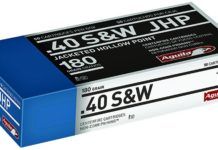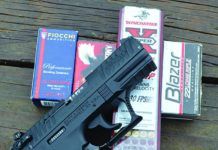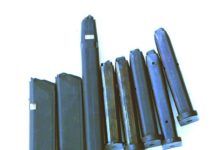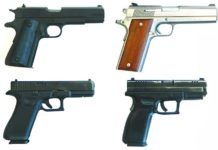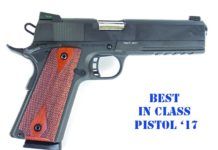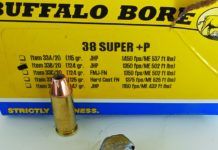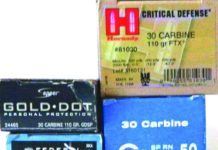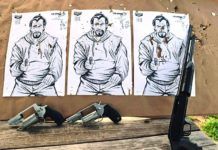New Handguns and Ammo for 2018
Gun Tests reporters and editors on the scene at SHOT Show 2018 in Las Vegas scoured the show for new pistol and handgun accessory entries for our readers to consider this year. Amazingly, a handgun made of steel with a design more than 100 years old — the fabled 1911 — still drives the market. A third of the new guns that follow are based on this legendary platform, followed closely by pocket pistols, and it's clear the revolver is not the antiquated firearm many assume. In fact, when it comes to handguns, 2018 is a good mix of old, new, plastic, and steel, with a wheelgun or two thrown in for good measure, along with loads for defensive handgun use to feed these new beasts. Here's a rundown on a few new handgun and ammunition choices for 2018 that our staff thought were notable and which we'll be looking to include in future issues.
Bad Luck with Ammunition
Hey Gun Tests, just finished reading the April issue. Another great issue. One thing I wanted to point out was the affordable ammo tests. I personally love those kinds of tests. It also shows me that I am in the minority on the Remington Thunderbolt 22 LR ammo. I've bought a few boxes of that stuff throughout the years and it hasn't performed that well in any of my 22s. I'm the customer that gets the boxes with the duds in them. Or the bullets that do not cycle the gun at all. CCI Blazer is my affordable 22 ammo of choice. Shoots quite well in my rimfires. I also loved the home-defense section, too. Keep that kind of test coming as well. Thanks for making the best firearms magazine out there.
224 Valkyrie Cartridge Specifications Approved
Affordable Handgun Ammo: Is It Up to Par for Your Firearms Use?
A few months ago we received an insightful comment from a reader. He asked us to do an ammunition comparison on inexpensive loads from diverse makers. How do they perform, he asked, compared to the big three (Federal, Remington, and Winchester) and the well-known Black Hills, Hornady, and Speer, and a few more. We are lucky to have so many choices, and because most, if not all, manufacturers subscribe to SAAMI standards, the ammunition should be safe and reliable.
There are two aspects to reliability: feeding and chambering properly and then going bang. We have run across poor ammunition that fail on either or both counts, but most of it is surplus ammunition from third-world nations. We won't discuss it here. If a brand makes it to the national market, the product has some merit.
There are economy loads that offer jacketed hollowpoint (JHP) bullets, and most of these do not have the development behind them that the Big Three loads do. However, we did test some JHP loadings in this report because they were as inexpensive as any other loads, and, in some cases, were all that was available. The goal of this report was to fire as many types of ammunition as possible in both popular and less popular calibers and determine if we were getting our money's worth in practice ammunition.
Safety came first, then reliable function. We also paid attention to powder burn. We have had experience with foreign-produced ammunition that simply did not have the powder technology of our domestic loads and the result was a lot of powder ash. If a load was particularly dirty — lots of smoke and debris — we took that into account.
Thankfully, the recent ammunition shortage that now seems to have abated had us searching out and trying anything we could find. Brand loyalty took a hit. So it is good to know if these inexpensive loads will function and if they are accurate enough for practice. Some of us like to fire for accuracy at longer ranges, but nothing tested wasn't accurate enough for practice at 15 to 25 yards. Some of the loads tested are among the very few available in certain calibers. There isn't a broad choice in 32 Smith & Wesson Long and 38 Smith & Wesson, as two examples.
It is worth noting that one of the raters has different criteria for loads, and they are reliability, dirtiness, and speed. His old Colt will not feed hollowpoints, so he concentrates on finding reliable rounds, getting a clean burn, and generating velocity, goals that are worthwhile to pursue.
As we told the reader who asked for this test, in our gun evaluations we strive to be fair and present a level playing field. That is why we use proven ammunition when testing a new gun. We generally include a generic ball load and one or two defense loads from the major makers when testing a new gun. This is only fair. Testing an unknown load with a new gun may not prove anything — does the ammunition or the gun bear the responsibility for failures? As one of our raters noted in his work at our sister publication, the well-respected American Gunsmith, and as a private gun fixer, he keeps a supply of generic ball from Federal, Fiocchi, Black Hills, Speer, and Winchester on hand. The gun is sick if it doesn't feed these loads. By the same token, when testing the ammunition in this report, we did not pick up new guns, but instead relied on proven firearms from our team's collections that have proven reliable and reasonably accurate.
We were able to collect loads in thirteen calibers for use in this feature. During the test, our shooters used a Bullshooters pistol rest to confirm accuracy. Some of the results were excellent, others poor, and most fair. Accuracy is relative, and the 38-caliber Iver Johnson break-top would not be in same accuracy range as a tuned 45 ACP or 9mm pistol, but we expected some type of pattern.
One note about these burner loads: Brand performance isn't always consistent among the makers of inexpensive ammunition. One maker may have a poor load in one caliber and a standout in another. Let the buyer beware, but we found good loads for practice in most cases. We fired at least 50 rounds of each load tested, including 35 rounds off hand and three five-shot accuracy groups. Accuracy testing was conducted at a distance appropriate for the handgun.
In each case, we describe the performance of the test rounds, but we highlight one round in particular that we recommend.
Non-1911 Magazines: We Test A Passel of Them Head to Head
You can never have enough magazines. Modern pistol shooters practice hard; compete in IDPA, IPSC, and Three Gun matches. They need reliable equipment. Personal-defense shooters need reliable, functional magazines at a fair price. In this installment, we are testing magazines for fit, function, reliability and durability. In common with recoil, striker, and hammer springs, magazines should be replaced from time to time. While new springs may help magazines retain some function, there is a time when cracked or bent feed lips demand the magazine be discarded.
In this test, we followed the same criteria we used in testing 1911 magazines, except this test was more diverse in both handguns and cartridges. The handguns used in the test were proven examples, with few function exceptions. Since the firearms had long-ago proven reliable, there would be no confusion as to which part was responsible for the malfunction, the pistol or the magazine. We also used good-quality ammunition to test the magazines. In each case, we used at least two magazines of each type to bang on.
Using proven criteria and a team of experienced raters, we learned some magazines were durable and service grade; that is, we would be comfortable putting them into "service" in critical situations. We also learned others were okay for range use, but not critical use. In all of these cases, we recommend spending a little more for service-grade magazines across the board for all uses. We don't think it's advisable to mix low performers with high performers in this critical area of function.
Hot Handguns and Cartridges From Springfield, Coonan, Glock
For more than a year, we have been testing and evaluating some of the most powerful and interesting self-loading handgun cartridges. These are the ubiquitous 9mm Luger, which we think has become the baseline against which all other handgun chamberings can be compared, and the far-less-common but still commercially viable 38 Super, 357 SIG, and 357 Magnum, the last of which is chambered in a Coonan handgun. The evaluation was the result of a reader request, and three of which, the 9mm, 38 Super, and 357 SIG, sometimes use the same bullets, but at different velocities.
We began with a number of goals. First, as always, reliability has to be foremost because the handguns were competing as personal-defense choices. We also viewed them as outdoors-carry choices for defense against feral dogs and big cats. We wanted to see how efficiently each cartridge delivered its power, with the idea that the 9mm set the floor. Increased flash, blast, and recoil may be counterproductive in the others, and as it turned out, we got more horsepower with less recoil than expected. The energy difference wasn't incremental; it was profound. We didn't choose average 9mm or 38 Super loads, but instead picked those loads that had given good results in the past. Only the top performers in 9mm and 38 Super are in this report. With the 357 SIG and 357 Magnum, we were on new ground and chose a representative sample of bullet weights. The 357 SIG and 357 Magnum enjoy an excellent reputation for terminal ballistics. The 9mm, less so, and based on previous data, we expected the 38 Super to be as effective or more than a 9mm Luger +P+ load. The primary consideration was personal defense, so control was important. The larger guns may not be ideal for concealed carry, but would be good handguns for field use or home defense. For those wishing to deploy a handgun with plenty of power and accuracy, the 357-caliber self-loaders are easier to control than Magnum revolvers. The self-loaders demonstrate less recoil due to the smaller charge of faster-burning powder and the movement of the action and compression of springs as the handgun is fired. So how would they compare to the revolver? As it turned out, these modern powerhouses outclass the 357 Magnum revolver, in our opinion, on many levels.
We collected a good supply of ammunition, five loads for each gun versus our usual three. We chose three powerful hollowpoint loads for accuracy testing, as is SOP for Gun Tests. We added a fourth load for ballistic testing to test penetration and expansion. We added an economical practice load for use in the combat-firing test phase. So, this was a thorough test requiring several months. We elected not to go lighter than 115-grain bullets in any chambering. The 357 SIG, 38 Super, and 9mm Luger are usually loaded with bullets in the range of 115 to 147 grains. We fired 125-, 140-, and 158-grain bullets in the 357 Magnum Coonan. Here are the results.
2017 Guns & Gear Top Picks
Toward the end of each year, I survey the work R.K. Campbell, Roger Eckstine, Austin Miller, Robert Sadowski, David Tannahill, Tracey Taylor, John Taylor, and Ralph Winingham have done in Gun Tests, with an eye toward selecting guns, accessories, and ammunition the magazine's testers have endorsed. From these evaluations I pick the best from a full year's worth of tests and distill recommendations for readers, who often use them as shopping guides. These choices are a mixture of our original tests and other information I've compiled during the year. After we roll high-rated test products into long-term testing, I keep tabs on how those guns do, and if the firearms and accessories continue performing well, then I have confidence including them in this wrap-up.
38 Super Loads: We Like Buffalo Bores Jacketed HPs
The 38 Automatic Colt Pistol Super cartridge isn't our most popular handgun cartridge, but in the loyalty of a small following it is unique. The 38 ACP Super must be understood as to its potential. All modern loads are marked 38 ACP Super +P, but all loads are in the same pressure range of safety demanded by the SAAMI, despite very different performance. Many are loaded below the potential of the cartridge. The 38 ACP, introduced in 1900, is no longer in regular production. This is because the original 38 ACP, introduced in 1899, was later upgraded to the powerful 38 ACP Super. Though the cartridge-case dimensions are identical, the Super is the much hotter cartridge. Modern SAAMI standards called for the 38 Super to be labeled 38 ACP Super +P, which is confusing. While some of the modern loads are hotter than others, all are safe for a 38 ACP Super handgun in good condition. The old double-link Colt 38 ACP self loaders should never be fired with Super loads. The 38 Super was once a handloading proposition for maximum performance. Using 9mm JHP bullets and sometimes heavy hard-cast 38 Special lead bullets, handloaders upgraded the 38 Super. The 115-grain JHP was jolted to 1400 fps or beyond. Today Cor-Bon, Buffalo Bore, and Double Tap offer high-performance loads rivaling some of the hotter handloads of yore. The 38 Super may be enjoying an upsurge in popularity as both Federal Cartridge Company and SIG Sauer have introduced new JHP loads for it. We were able to find 12 personal-defense loads and four FMJ loads. For all the testing, we fired the rounds out of a Rock Island Armory 1911, a reliable and affordable 38 Super launchpad. It's a standard Government Model steel-frame pistol with 5-inch barrel.
First, we tested the full-metal-jacket loads for use in competition and general shooting. We recorded basic accuracy, velocity, and energy for these rounds, but as you'll see in the accompanying table, their widths, weights, and penetration readings are all the same. The FMJs didn't expand, didn't shed weight, and shot through our water-jug lineup, putting them at +24 inches, penetration beyond what we recommend for self-defense.
The Fiocchi 129-grain FMJ proved to be the most accurate by a margin, with a clean burn and excellent overall performance. It is the Best Buy for accuracy and economy. The SIG Sauer 125-grain FMJ loading was close behind the Fiocchi loading, with little real difference other than price. While the Prvi Partizan 130-grain FMJ was less expensive, it did not burn as cleanly nor was it as accurate. The Winchester 130-grain FMJ was the most expensive, and it was middle of the pack in terms of performance. Accordingly, we'd rate the Fiocchi as an A, the SIG an A-, the Prvi Partizan a B, and the Winchester a B-.
We looked for what we always look for in personal-defense loads. This is reliability first, then accuracy, a clean powder burn, and a good balance of penetration and expansion. We prefer a load that penetrates and expands over a load that fragments. In the 38 Super, there were loads that penetrated well but also fragmented, and we had to give them a passing grade based on penetration. The full-power 38 Super is similar to the 357 Magnum with 110- to 125-grain bullets, but the Super is much more controllable and has less muzzle blast and recoil. Relatively small charges of fast-burning powder create less recoil energy than larger charges of slow-burning powder. Even the fastest loads did not create muzzle flash and blast as sometimes seen with the 357 Magnum. The 38 Super isn't in the class with the 357 Magnum as far as heavy hunting loads, and the Magnum at its best will beat the 38 Super, but with factory defense loads, the two are comparable, with the 38 Super having the advantage in some cases. For your convenience, we have added the 357 Magnum results panel from earlier this year so you can compare the loads.
We were able to test three loads from Buffalo Bore. These included 115-, 124-, and 147-grain loads. All of these used the Hornady XTP bullet, a proven projectile for obtaining excellent penetration and expansion. These bullets were designed for the 9mm Luger, and things get interesting when the bullet is supercharged by 200 fps. As an example, one rater noted he was no enthusiast concerning the 147-grain load, but that was before it was tested. Here are the results round by round.
Slugs For Self Defense: These Shotgun Rounds Rock
Not long ago a reader asked for a feature on shotgun slugs. He asked for a report on not only the usual fare found in most sporting-good shops, but also the most powerful slugs for personal defense. The standard for many years has been the 1-ounce (437.5 grain) slug at 1500 fps or so. Then the reduced-recoil slugs were introduced for police use and found much popularity among civilian shooters. Some slugs are designed to limit penetration, and there are slugs intended for use in a situation when extra penetration is needed. There are areas in which only shotguns are allowed for hunting, and it is good to have a choice among slugs for long range and large animals. We focused on slugs for home defense and animal defense. As such, there was necessarily a dual rating system, which we noted in each segment. Limited penetration is desirable in most home-defense situations. For use against bears, the greatest penetration is needed. Some of these slugs are accurate well past 50 yards, even 100 yards in a rifled slug barrel. In a proper rifled shotgun barrel, we feel that Lightfield's claims of accuracy to 150 yards would be borne out.
These are big chunks of lead. They produce a considerable wound track whether they expand or not. We took a hard look at these slugs and found interesting performance. We also found a great deal of recoil. As an example, the strongest Lightfield slug measured a 933 power factor. We debated including PF, as it isn't the same thing with a long gun as a handgun, but kept the figures because they are useful for comparing recoil. The heaviest slugs have nearly twice the recoil of the average full-power 30-06 rifle load. Keep this in mind. The test ended with sore shoulders, one broken nail, and quite a bit of use of penetrating ointments! Most folks will not go to the range and fire 40 full-power slugs from a riot gun in one morning. As our former police firearms instructor noted, it isn't about putting down a lot of lead, but you can do that with the reduced-recoil slug. If you need to stop one of the big cats, a feral dog, or a bear, then you need to get on target and make every shot count. The level of energy these shotgun slug loads displayed is impressive.
During the research, we also consulted some who had faced big bears, including grizzlies. One correspondent had not shot a grizzly, but as a young man was given the task of skinning one that has been taken down by Canadian authorities. He told us that they are nothing like a moose or a brownie. The attachment of the sinew, the ligaments, he noted, simply wore out knives and cleavers. It was quite a chore. Large, aggressive animals are very dangerous and very tough. While shotgun slugs have their place against a grizzly, a 375-caliber or larger rifle might be the better choice. Just the same, these slugs gave good performance. For personal defense, the reduced-recoil loads are excellent, while the full-power loads would be effective against cougars and brown bears, not to mention the ever-dangerous feral dog and, the most dangerous, criminals. As for our choice of shotgun for testing, the pump action shotgun is used by many of us for home defense. It is the type of shotgun that would be kept in a light plane in Alaska or the back of a truck just in case. The 18-inch riot gun delivered good performance, we felt, and while the recoil of some of these loads were doubtless more than many would like to handle, the performance on target was also impressive. Velocity was less than the rated velocity of most slugs, as they are designed for use in a 24- to 28-inch barrel hunting shotgun. As one of the raters noted, both the Remington 870 shotgun and a 165-pound rater were fighting out of their weight class firing some of these slugs.
Here's what our shooters and the water jugs said about each round.
Peruta Declined Supreme Court Hearing
I was disappointed to see that on June 26, the U.S. Supreme Court decided not to hear Peruta v. California. A Supreme Court decision would have answered some important legal questions: Does the Second Amendment's coverage for people to keep and bear arms extend outside the home? Does it cover the right to carry concealed firearms in public? Peruta might have provided definitive legal answers to those questions. Gun owners already know the answers, so we're frustrated that a natural right to self protection is hemmed in by state statutes.
30 Carbine Picks: Hornady, Speer, Buffalo Bore Loads Tested
The 30 Carbine cartridge is an interesting and historically significant round. The M1 Carbine was the first little-maintenance firearm issued to the U.S. Army and was also among the first firearms that might correctly be called a Personal Defense Weapon (PDW). Designed for military officers, back-area troops, truck drivers and other personnel not usually armed with a rifle, it was specifically intended to allow officers to carry a lightweight rifle that was more powerful and accurate than a handgun. The carbine was not a short-barrel full-power rifle as earlier carbines had been, being instead designed for a lower-powered cartridge compared to the 30-06 cartridge used in the M1 Garand. Compared to the Russian M44 or the British No. 5 carbine, the M1 carbine is much easier to use well and handle. The M1 Carbine was designed for close-range area defense and personal defense. The concept was successful, and eventually, the army manufactured more than 6 million carbines. Numerous police agencies used the M1 carbine, including post-war Berlin and the NYPD. For close-range battle, the M1 carbine has much to offer.
We feel that the attributes of the M1 Carbine might make it even better suited to home defense than the typical AR-15 rifle. For hunting use and predator control, not so much. We cannot recommend the energy level of the 30 Carbines for deer-sized game, but its low recoil and low muzzle flash are essential for home defense, and the 30 Carbine offers both, but with 357 Magnum energy. The rifle is ergonomic and provides high hit probability. We admit the standard 110-grain FMJ load at about 2000 fps isn't the best choice for home defense, based on over penetration and a lack of wound potential. There have been 110-grain jacketed soft points and jacketed hollowpoints used by police agencies, but most of these loads seem out of production by old mainstays Winchester and Remington. Still, we were able to collect loads using modern expanding bullets and compare them for accuracy penetration and expansion. What we found was that accuracy is good to excellent for all loads, although some were more accurate than others. For use in the home or area defense and animal defense against feral dogs and coyotes to 50 yards or more, the little rifle is plenty accurate. While we find there was something to recommend about all the loads tested, there are standouts. The Buffalo Bore full-power load and the Speer Gold Dot are at the top of the pack for home defense, with the Critical Defense load a strong contender for tactical use.
In this test, we fired 50 cartridges of each load, which included three cartridges each for penetration and expansion testing and fifteen cartridges (three five-shot groups) for accuracy. The remaining 32 rounds were fired in off hand shooting for personal defense work at 5, 7, and 25 yards. We tested accuracy from 25 yards. The rifle was a vintage Israel Arms International carbine. Here are the results.
.410 Bore Self-Defense Choices
The decision of which self-defense .410 firearm is the correct choice for up-close-and-personal situations encountered in the home often comes down to a handgun in one hand or a short-barreled pump-action shotgun in the other. Because of their ease of handling, two revolvers that are capable of firing both .410 loads and handgun rounds are becoming quite popular; and pistol-grip short-barrel shotguns remain a favored option in self-defense circles. The question arises about which type of close-range firearm is the most effective with the diminutive .410 loads, including those that have recently been developed with short-barreled revolvers in mind.
Acting on a reader request, we conducted a multitude of tests on a trio of readily available self-defense firearms that included a Taurus Judge (handles .410-bore shotshells and 45 Colt) that retails for $629; a Smith & Wesson Governor (handles .410, 45 Colt, and 45 ACP) that retails for $809; and a Mossberg Model 500 Cruiser that sells for $467 and fires .410-bore shotshells.
Each of the firearms (all have been examined in previous GT reviews) is specifically designed for close-quarters action, such as when an intruder has illegally entered a residence, placing the people living in the home in a potentially life-threatening situation. In such a life-or-death scenario, a reliable, easy-to-handle, and effective self-defense tool is essential.
In this part of the GT evaluation and match-up, our focus was on the handling ability of the three firearms and their patterning performance at close-quarters ranges. We attempted to walk the fine line that divides ease of handling with putting the pattern in the right place to evaluate the two revolvers and the pump-action.
We tested the firearms on the range with targets set at two ranges used in concealed carry courses to simulate typical home-defense scenarios. The close targets were set at 9 feet (3 yards) and the second set of targets was shot at 21 feet (7 yards). Here are our findings.






























